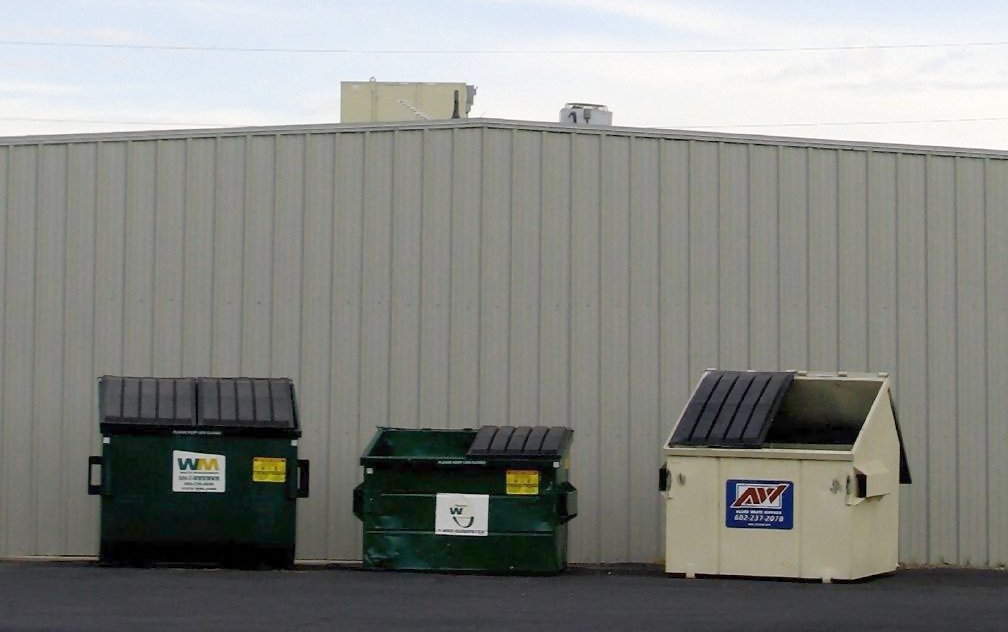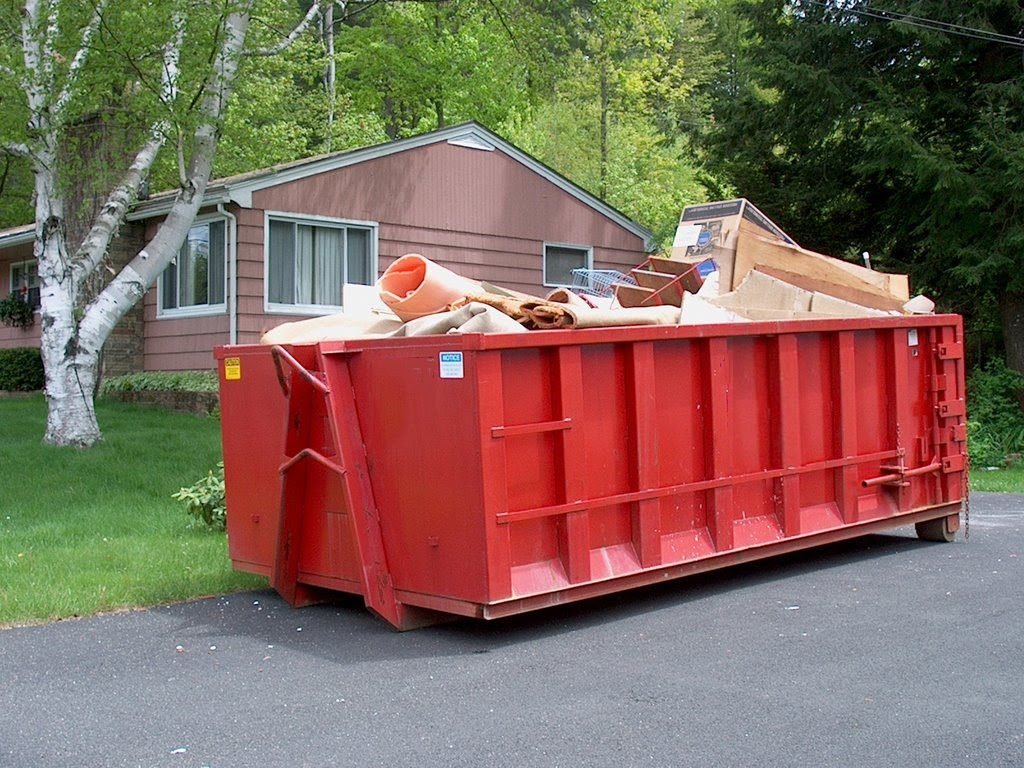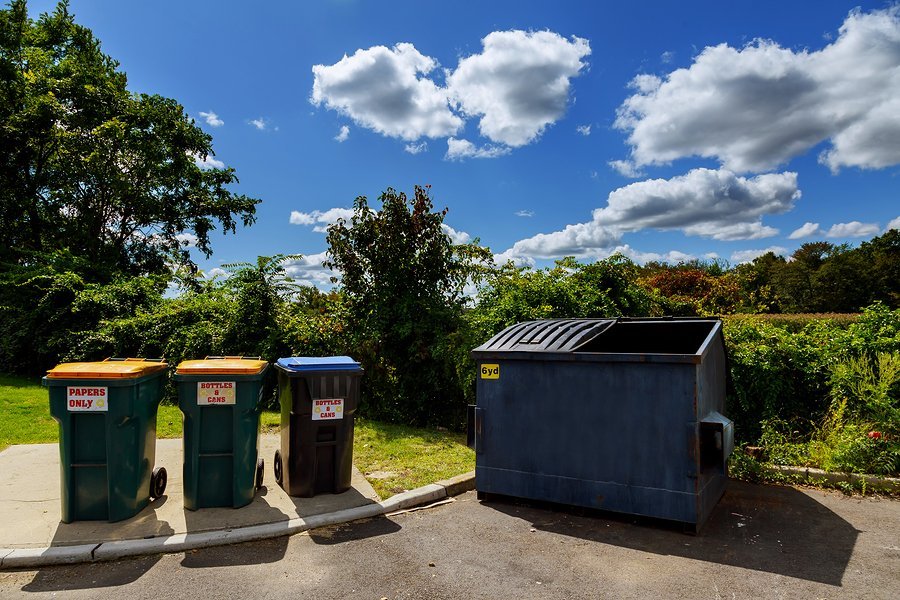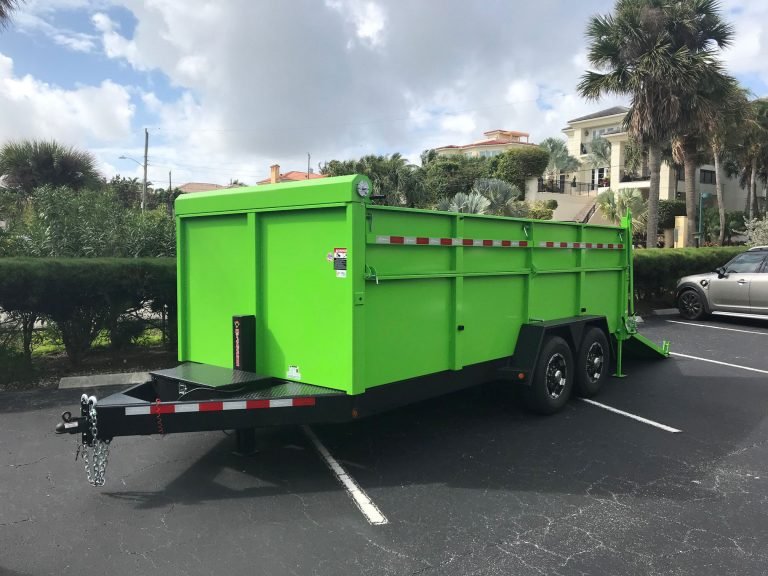Dumpster placement plays a crucial role in the affordability and convenience of dumpster rentals in Miami, FL. Properly positioning dumpsters not only ensures efficient waste management but also minimizes costs associated with transportation and disposal. To illustrate this point, consider the hypothetical scenario of a construction site where multiple renovations are taking place simultaneously. Inefficient dumpster placement could lead to increased labor expenses as workers spend valuable time hauling debris across long distances. Thus, understanding the significance of strategic dumpster placement is paramount for individuals or organizations seeking cost-effective solutions for their waste management needs.
Optimizing dumpster placement involves careful consideration of several factors specific to the location and intended use. Firstly, an assessment must be made regarding the proximity of various sources generating waste materials to potential dumpster locations. For instance, in residential areas undergoing home renovations or remodeling projects, it is essential to position dumpsters close to households or buildings that generate substantial amounts of debris. This reduces the effort required by residents or construction workers to transport waste over extended distances, resulting in enhanced efficiency and reduced labor costs. Similarly, at commercial sites such as shopping centers or office complexes, placing dumpsters strategically near loading docks or high-traffic areas can facilitate easy access for employees and minimize disruption during collection and removal processes.
Furthermore, considering logistical aspects like traffic flow, available space, and access points is crucial in determining the ideal placement of dumpsters. In busy urban areas like Miami, where traffic congestion can be a challenge, it is essential to position dumpsters in locations that do not impede the movement of vehicles or pedestrians. This ensures smooth operations and prevents potential accidents or delays.
Additionally, evaluating the available space on the premises is necessary to determine if there is enough room for a dumpster and if any restrictions or regulations exist regarding its placement. Some municipalities may have specific guidelines on setback distances from buildings or property lines that must be adhered to. By considering these factors beforehand, individuals or organizations can avoid penalties or fines associated with non-compliance.
Lastly, identifying convenient access points for waste removal services is vital for efficient dumpster placement. Dumpster rental companies typically require easy access for their trucks to collect and replace dumpsters when needed. Therefore, placing dumpsters near entrances or designated pickup zones can expedite this process and minimize disruptions to daily operations.
In conclusion, strategic dumpster placement plays a crucial role in optimizing affordability and convenience in dumpster rentals in Miami, FL. By considering factors such as proximity to waste sources, logistical aspects like traffic flow and available space, and convenient access points for waste removal services, individuals or organizations can ensure efficient waste management while minimizing costs associated with transportation and disposal.
Factors to Consider for Dumpster Placement
When it comes to renting dumpsters, proper placement is key in order to ensure efficient waste management and cost-effective solutions. The location where a dumpster is placed can have a significant impact on various factors such as accessibility, safety, and convenience. By considering the following factors, individuals can make informed decisions about dumpster placement that will ultimately contribute to successful waste disposal.
One crucial factor to consider when determining dumpster placement is accessibility. Placing the dumpster in an easily accessible area allows for convenient loading and unloading of waste materials. For example, imagine a construction site where workers need to dispose of debris frequently throughout the day. If the dumpster is located far away from the work area, it would require additional time and effort for workers to transport the waste materials, potentially leading to decreased productivity. Therefore, placing the dumpster in close proximity to where waste is generated minimizes downtime and maximizes efficiency.
In addition to accessibility, safety should also be taken into account when deciding on dumpster placement. Ensuring that the chosen location does not obstruct pathways or impede traffic flow is essential for maintaining a safe working environment. Furthermore, it is important to consider any potential hazards associated with specific sites or activities. For instance, placing a dumpster near flammable materials or electrical equipment could pose a fire risk. By carefully assessing these safety concerns beforehand and selecting appropriate locations accordingly, individuals can mitigate potential accidents and promote overall workplace safety.
Moreover, aesthetics play a role in effective dumpster placement as well. Nobody wants an unsightly trash container detracting from the visual appeal of their property or surroundings. To address this concern, individuals may choose discreet areas for dumpster placement that are less visible or strategically screen them with landscaping elements such as shrubs or fences. This way, both practicality and aesthetic considerations are met without compromising functionality.
Considering all these factors together can lead to optimal decision-making regarding dumpster placement – one that balances accessibility for easy waste disposal, safety for a hazard-free environment, and aesthetics to maintain the visual appeal of the surroundings. By prioritizing these aspects, individuals can ensure that their dumpster placement choice aligns with their specific needs and requirements.
Moving forward, let us now explore ideal locations for dumpster placement as we continue our exploration into efficient waste management strategies.
Ideal Locations for Dumpster Placement
When it comes to dumpster placement, there are several factors that need to be taken into consideration. One such factor is the proximity of the dumpster to the area where waste is generated. For example, in a construction site scenario, placing the dumpster as close as possible to the work area can greatly improve efficiency and save valuable time.
Another important factor to consider is accessibility. Placing dumpsters in areas with easy access ensures that they can be loaded and unloaded quickly and without any hindrance. This may include avoiding narrow or congested pathways and ensuring that there are no obstacles such as trees or utility poles blocking the way.
Additionally, local regulations and restrictions play a significant role in determining dumpster placement. Some municipalities have specific guidelines regarding where dumpsters can be placed, especially in residential areas. It is crucial to familiarize yourself with these regulations beforehand to avoid any potential fines or penalties.
To further illustrate these considerations, let’s look at a hypothetical case study:
Imagine a large commercial building undergoing renovations in downtown Miami. The contractors need a dumpster on-site to dispose of construction debris promptly. By strategically placing the dumpster near an entranceway but away from pedestrian traffic, workers can easily discard materials while minimizing disruptions for passersby.
Considering these factors when deciding on dumpster placement will not only streamline waste management processes but also contribute to efficient operations overall.
Now let’s delve into some emotional aspects related to proper dumpster placement by highlighting four key benefits:
- Improved safety: Properly placed dumpsters reduce tripping hazards and ensure clear pathways.
- Enhanced cleanliness: Strategic placement prevents littering and promotes tidiness in surrounding areas.
- Increased productivity: Easy access saves time and effort during loading and unloading activities.
- Minimized environmental impact: Well-placed dumpsters help prevent spills or leaks that could harm ecosystems nearby.
Table: Emotional Benefits of Proper Dumpster Placement
| Benefit | Description |
|---|---|
| Improved Safety | Reduced tripping hazards and clear pathways |
| Enhanced Cleanliness | Prevention of littering and promotion of tidiness |
| Increased Productivity | Time and effort saved during loading and unloading activities |
| Minimized Environmental Impact | Prevention of spills or leaks that could harm nearby ecosystems |
With these emotional benefits in mind, it becomes evident why proper dumpster placement is a crucial aspect to consider.
Proper Sizing of Dumpsters for Efficient Placement
Imagine a scenario where you are renovating your home in Miami, FL. You have rented a dumpster to efficiently manage the waste and debris generated during the process. Now that you have selected the appropriate size of the dumpster, it is essential to determine the ideal placement location. Proper placement ensures convenience, accessibility, and cost-effectiveness throughout your project.
When considering the placement of dumpsters on your property, there are several key factors to keep in mind:
-
Proximity: Place the dumpster as close as possible to the area where most of your renovation or construction work will be taking place. This reduces time wasted walking back and forth with debris and minimizes interruptions in workflow.
-
Accessibility: Ensure easy access to both the dumpster itself and its surroundings. Avoid placing it near obstacles such as trees, fences, or utility lines that may hinder movement or pose safety risks when disposing of heavy items.
-
Stability: Choose a flat and stable surface for optimal stability of the dumpster. Uneven ground can lead to instability and potential accidents during loading or unloading processes.
-
Legal Considerations: Familiarize yourself with any local regulations regarding dumpster placement in Miami, FL. Some neighborhoods might require permits or specific guidelines for proper placement. Adhering to these regulations not only avoids fines but also maintains good relations with neighbors and local authorities.
Consider this hypothetical case study illustrating how proper dumpster placement can streamline your renovation project:
| Property Type | Renovation Scope | Optimal Dumpster Placement |
|---|---|---|
| Single-family | Kitchen remodeling | Driveway adjacent to kitchen entrance |
| Apartment | Bathroom renovations | Parking lot nearest building entrance |
| Commercial | Office expansion | Empty space at rear of building accessible by service entrance |
By following these best practices for efficient dumpster placement, you can ensure a smooth renovation process, reduce costs, and enhance overall productivity.
Permit Requirements for Dumpster Placement
To comply with local regulations and avoid potential penalties, it is crucial to understand the permit requirements associated with dumpster placement in Miami, FL. Stay tuned to learn about the necessary permits and guidelines that should be followed when placing dumpsters on your property.
Permit Requirements for Dumpster Placement
Dumpster Placement in Miami FL: The Key to Cheap Dumpster Rentals
Proper Sizing of Dumpsters for Efficient Placement
When it comes to dumpster placement, selecting the appropriate size is crucial for ensuring efficient waste management. To illustrate this point, consider a hypothetical scenario where a construction site in downtown Miami requires a large-scale renovation. With limited space available on-site and frequent debris accumulation, choosing the right-sized dumpster becomes paramount.
To guide you in making informed decisions regarding dumpster sizing, here are some key considerations:
- Scope of the project: Assess the scale and duration of your project to estimate the volume of waste generated. This will help determine the appropriate size of dumpster needed.
- Available space: Evaluate the area where you intend to place the dumpster. Consider any potential obstacles or restrictions that may affect its positioning.
- Waste composition: Different materials have varying densities and require different amounts of space. If your project involves heavy items such as concrete or bricks, opt for a larger dumpster with higher weight-bearing capacity.
- Cost efficiency: While it may be tempting to choose a smaller dumpster to save money initially, it could result in more frequent pickups and increased costs in the long run. It’s important to strike a balance between cost-effectiveness and sufficient capacity.
Considering these factors when selecting a dumpster size ensures optimal utilization and streamlines the waste removal process.
Permit Requirements for Dumpster Placement
In addition to proper sizing, it is vital to understand and comply with permit requirements for dumpster placement within Miami city limits. Failure to do so can lead to fines or delays in your project timeline. The table below outlines essential information related to obtaining permits:
| Type of Permit | Purpose | Application Process |
|---|---|---|
| Construction | Required for dumpsters placed at construction sites | Submit application online or by mail |
| Commercial | Necessary for dumpsters located at commercial premises | Apply in-person at local government offices |
| Residential | Mandatory for dumpsters placed in residential areas | Submit application online or by mail |
As the permit application process may differ depending on your project’s location and nature, it is advisable to consult with local authorities or visit their websites for detailed instructions.
By adhering to these permit requirements, you can avoid potential legal issues and ensure a smooth dumpster placement experience.
Tips for Maximizing Space with Dumpster Placement
To make the most of limited space when positioning your dumpster, there are several strategies you can employ:
- Compact waste items: Break down large objects into smaller pieces whenever possible to optimize available space.
- Stack efficiently: Arrange debris neatly within the dumpster, stacking materials vertically rather than spreading them out horizontally.
- Use vertical space: Utilize the full height of the dumpster by placing lighter items on top of heavier ones, ensuring maximum capacity utilization.
Implementing these techniques will help maximize the use of your rented dumpster and ultimately reduce costs associated with additional pickups or larger containers.
Transitioning smoothly into our next section about “Tips for Maximizing Space with Dumpster Placement,” let us now explore practical steps that further enhance efficiency in utilizing available dumpster space.
Tips for Maximizing Space with Dumpster Placement
Understanding the permit requirements for dumpster placement is crucial, but it’s equally important to consider strategies that can help you make the most of your available space. By optimizing your dumpster placement, not only will you be able to fit more waste into each container, but you’ll also save money on rental costs. Let’s explore some tips for maximizing space with dumpster placement.
Tips for Maximizing Space with Dumpster Placement:
To illustrate these tips, let’s imagine a hypothetical scenario where a construction company in Miami needs to dispose of various materials during a renovation project. By implementing the following suggestions, they were able to optimize their dumpster usage and significantly reduce expenses:
-
Efficient Loading Techniques:
- Break down large items or dismantle them when possible.
- Flatten cardboard boxes before placing them in the dumpster.
- Strategically stack smaller items and debris to utilize vertical space effectively.
-
Proper Segregation:
- Separate recyclable materials such as glass, metal, and plastic from general waste.
- Arrange different types of waste separately within the dumpster using dividers or compartments.
-
Compactness Matters:
- Utilize heavy objects or materials as anchors at the bottom of the dumpster.
- Crush bulky items like furniture or wooden planks before disposal.
- Fill voids and gaps between items with smaller debris instead of leaving empty spaces.
-
Consider Alternative Disposal Options:
- If feasible, donate usable items or recycle certain materials rather than disposing of everything in the dumpsters.
By incorporating these space-maximizing techniques, our hypothetical construction company was able to reduce their overall number of dumpsters required while maintaining efficient waste management practices.
| Trash Item | Quantity | Volume (in cubic feet) | Savings (in rental costs) |
|---|---|---|---|
| Cardboard boxes | 50 | 5,000 | $100 |
| Recyclable glass | 20 containers | 1,000 | $80 |
| Furniture pieces | 10 | 2,500 | $120 |
| Miscellaneous waste | – | – | – |
Taking into account the case study above and the potential savings achieved through optimized dumpster placement, it becomes clear that these strategies are essential for cost-effective waste management.
Now let’s delve into common mistakes to avoid with dumpster placement to ensure an efficient and hassle-free disposal process.
Common Mistakes to Avoid with Dumpster Placement
Having discussed some valuable tips on maximizing space when placing dumpsters, it is important to also be aware of common mistakes that should be avoided. By steering clear of these errors, individuals can ensure a smoother and more cost-effective dumpster rental experience.
Common Mistakes to Avoid with Dumpster Placement:
-
Blocking Access Points:
One frequent error made when placing dumpsters is obstructing access points such as driveways or loading docks. This can cause inconvenience and hinder the smooth workflow of businesses or residences. It is essential to carefully consider the placement location, ensuring it does not interfere with entryways, exits, or any other crucial pathways. -
Overloading Weight Restrictions:
Another mistake often encountered is exceeding weight restrictions specified by dumpster rental companies. Failing to adhere to these limitations may result in additional fees or even damage to property due to overweight containers. To avoid this issue, always consult with the rental company regarding weight capacities and distribute heavy items evenly within the dumpster. -
Ignoring Local Regulations:
Neglecting local regulations pertaining to dumpster placement can lead to unnecessary fines or penalties. Each city may have specific guidelines governing proper placement and permits required for dumpsters on public roads or sidewalks. Familiarize yourself with these regulations before renting a dumpster and ensure compliance during its placement. -
Neglecting Environmental Considerations:
Environmental factors are often overlooked when considering dumpster placement but failing to account for them can have serious consequences. For instance, locating a dumpster too close to water sources like rivers or lakes might pose pollution risks if waste materials seep into nearby bodies of water during heavy rainfall events. Always choose an appropriate location that minimizes potential harm to the environment.
- Protect your surroundings by minimizing the risk of accidents or damage.
- Avoid unexpected costs and penalties by adhering to weight restrictions and local regulations.
- Promote a smooth workflow by ensuring easy access for vehicles and pedestrians.
- Preserve the environment by preventing pollution incidents through responsible dumpster placement.
Emotional Table:
| Mistake | Consequence | Solution |
|---|---|---|
| Blocking Access Points | Inconvenience, hindered workflow, potential property damage if alternative pathways are used. | Choose a location that does not obstruct driveways, loading docks, or other access points. |
| Overloading Weight Limits | Additional fees from rental companies, potential property damage due to overweight containers. | Consult with the rental company regarding weight restrictions and distribute heavy items evenly within the dumpster. |
| Ignoring Local Regulations | Fines or penalties imposed by authorities for non-compliance with specific guidelines on placement permits or public road/sidewalk usage. | Familiarize yourself with local regulations before renting a dumpster and ensure compliance during its placement. |
| Neglecting Environment | Potential pollution risks if waste materials seep into water sources during rainfall events; harm to surrounding ecosystems and wildlife habitats. | Select an appropriate location away from water sources to minimize environmental impact while placing dumpsters responsibly. |
In summary:
By avoiding common mistakes in dumpster placement, individuals can enhance their overall experience when renting one in Miami FL. Taking into account factors such as access points, weight limits, local regulations, and environmental considerations will contribute to cost-effectiveness, safety, compliance, and preservation of surroundings. Being mindful of these aspects ensures a successful dumpster rental process without any unnecessary complications or negative consequences arising from improper placement choices.






